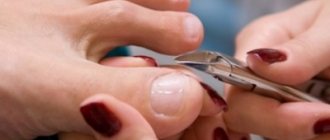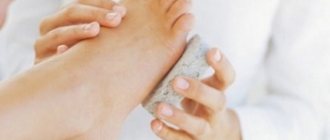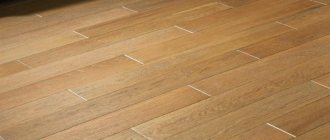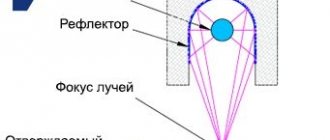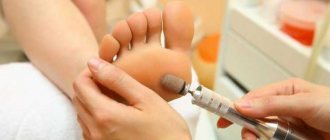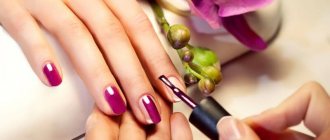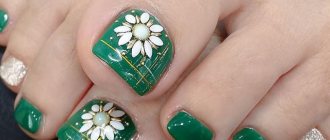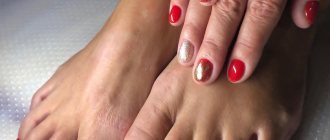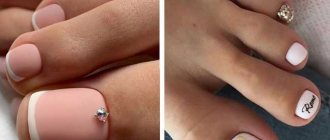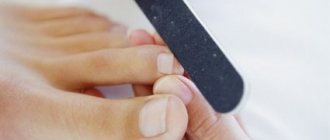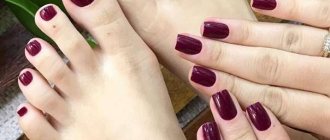Types of pedicure
To maintain the natural beauty of women's feet, modern cosmetology offers different pedicure techniques, the types of which can be divided into traditional and exotic. The list of traditional ones includes:
- classical;
- European;
- hardware;
- combined.
Innovative and exotic include:
- spa pedicure;
- acid;
- fish;
- Japanese.
Of all the existing varieties of skin and toe care, everyone can choose the best option for themselves. Moreover, many procedures can be carried out not only in expensive salons and beauty studios, but also at home. Their main differences lie in the use of certain tools, a set of special care products or special equipment.
Foot problems
Foot care is an integral part of everyday hygiene. However, it happens that a pedicure requires special actions performed by a cosmetologist or doctor. The need for this arises if the following problems occur:
- Ingrown toenails or the need for nail reconstruction.
- Calluses (areas of dead skin caused by pressure on the feet, which often cause burning and pain when walking).
- Cracks in the heels, and, as a result, infections and inflammations.
- Excessive sweating of the feet.
- Ringworm.
- HPV viral warts.
If you encounter the above problems, you should definitely seek advice from a specialist. You will need a long treatment process and proper care.
Classic pedicure
The technology of classic pedicure has been used for several centuries. The entire foot and nail care procedure includes several stages:
- The feet are steamed in a bath of warm water. Special softening and disinfectants, sea salt, baking soda, essential oils, decoctions and infusions of medicinal plants are added to the water.
- Treat the soles and heels with pumice, a file or a grater. If necessary, the rough skin is cut off using a machine with a sharp blade.
- Cuticles and overgrown skin are removed with scissors and nippers.
- Give the nails the desired shape - trim and file the nail plates.
- Nails are degreased, a decorative coating is applied to them, and hands are lubricated with a moisturizing and nourishing cream.
The advantages of a classic pedicure include its accessibility and simplicity. Purchasing a basic set does not require large financial expenditures, and every woman can master the classic pedicure technique if she wishes. Therefore, representatives of the fair sex often do trimmed pedicures on their own without visiting a beauty salon.
However, this technology also has a number of disadvantages:
- After the session, a woman may be bothered by itching and burning on the skin.
- If work tools are not properly disinfected, there is a risk of fungal or bacterial infections.
- The likelihood of getting cuts and microtraumas, curvature and ingrown nail plates increases.
Excessive cutting of the keratinized skin of the feet causes discomfort and pain, and also triggers regeneration processes and causes increased growth of epidermal cells. The skin on the heels and soles of the feet constantly becomes coarser and thickens, forcing the woman to turn to specialists again.
Pedicure tools
To get the best and lasting results from a pedicure, you need to pay special attention to the tool used.
Rules for choosing a tool
— compact size, comfortable to hold in hand; - sharp sharpened blade; — the best material for tools is stainless steel.
Variety of basic pedicure tools
1. Nail clippers. 2. Cuticle nippers (removing skin corners and hangnails). 3. Tweezers (cuticle trimming). 4. Scissors for toenails (cutting nails). 3. Pedicure pusher (separation of the cuticle, removal of the stratum corneum - pterygia). The pusher can be double-sided (with a curette or a spatula). 4. Pedicure scraper (a razor for cutting rough skin). 5. Pedicure file for shaping nails.
There are also a number of auxiliary tools and devices, these include: a pedicure bath, pedicure pumice stone for treating heels, napkins, cotton swabs.
European
To carry it out, you do not need to use cutting tools and steaming baths, so the innovative technique is often called dry or uncut.
European pedicure takes a long time. To achieve the final result, 5 to 10 procedures will be required. Using this gentle technique, it is impossible to tidy up neglected feet and toes. Therefore, it is more suitable for children, women and men with thin skin and well-groomed feet.
The main feature of dry pedicure is the use of special compounds - removers, which allow you to soften the cuticle, dissolve and remove it. If at first you carry out foot care according to the European method every 2 weeks, then later, when the cuticle becomes thinner, you can visit the salon no more than once a month.
Technology for unedged pedicure:
- The nail bed is treated with remover.
- After 5-15 minutes, the cuticle is removed with an orange stick, and the skin around the nail plates is sanded with a file.
- Model the shape and length of nails.
- The softening composition is applied to the skin of the feet and left for 15-20 minutes. Then the roughened epidermis is removed with a pumice stone or brush.
- Apply nourishing and moisturizing cream.
- They give a foot massage, which increases blood circulation and improves nutrition of skin cells and nail plates.
- At the client's request, a strengthening, healing or decorative varnish coating is applied to the nails.
European pedicure has many advantages. Its painless and safe technique eliminates the possibility of infection, the development of an inflammatory process or fungal infections of the skin and nails. With each subsequent session, the cuticle will become thinner, so with regular home foot care, an unedged manicure can be done no more than once every 4-5 weeks. The price for the services of a salon master with dry pedicure skills is low. The procedure itself is a unique way of relaxation and relaxation.
European pedicure
It can be called a variation of the classic. Its main difference is that during the procedure the cuticle is not cut off, but is carefully moved using a wooden stick after applying a special dissolving cream to the cuticle. Thanks to this procedure, cuticle growth significantly slows down. Plus the fabric is not damaged and there is no risk of getting a cut or scratch.
However, in order for the cuticle to be neat and even, this procedure must be carried out regularly, a total of 7-8 procedures should be carried out. Therefore, the probability of catching an infection is very high, but less than with a classic pedicure.
This pedicure is only suitable for well-groomed legs; in a situation where the legs are neglected, it is better to start with a classic pedicure. Read more about the French pedicure technique.
Hardware
This type of pedicure has long been included in the list of traditional salon services. It is carried out using a special device - a milling machine, which removes dead tissue and gently polishes the skin and nails. For high-quality care of toes and feet, cone-shaped and disk nozzles of different grain sizes are used, rotating at speeds from 6 to 40 thousand revolutions per minute. Consumables made from metal alloys or natural abrasives are selected individually, taking into account the shape of the nails and the structure of the client’s foot.
To remove the keratinized layer of skin, a specialist first applies a special solution or gel to the feet - a keratolytic, which softens the rough tissue.
Those with well-groomed feet can do without pre-treatment of the feet, because... You can also polish your heels using the device on dry skin.
Hardware pedicure helps to qualitatively treat the skin in the most inaccessible places, get rid of ingrown nails, calluses and corns, and prevent their reappearance. The procedure completely eliminates the risk of injury or infection of the skin.
Hardware pedicure
Hardware pedicure is done using a special technique, the operating principle of which is based on the rotation of rough attachments - cutters. When they come into contact with the skin, they clean off dead cells, which are pre-dissolved with a special product. This prevents damage to living cells.
After removing dead cells, the tips are changed to safely and quickly:
- cuticle removal;
- formation of the nail plate;
- polishing the nail.
Since living tissues are not injured during manipulation, the risk of infection is reduced to zero, but the softness and tenderness of the legs remains after such a session much longer than when using other types of pedicure.
Spa pedicure
To carry out this procedure, pedicurists use all kinds of scrubs, peelings, lotions, masks and other cosmetics containing a complex of useful components:
- extracts of medicinal plants and algae;
- mineral salts;
- essential oils;
- thermal water;
- healing mud.
Spa pedicure takes place in several stages:
- Steam your feet in a bath or using socks with a special lotion.
- Peeling is done with natural-based scrubs.
- Massage your feet.
- Apply products that nourish, moisturize, rejuvenate and heal the skin of the feet.
Spa pedicure gives your feet a well-groomed and healthy look, allows you to relax, relieve fatigue and enjoy peace. Many spas and beauty studios offer it. However, the cost of 1 session is high compared to other types of pedicure. This method of foot care is not suitable for people with problem skin, fungal infections of the skin and nail plates, or ingrown nails.
Unusual pedicure: TOP 3 varieties
If you are tired of traditional classic, hardware and SPA pedicure and want to try something new, pay attention to unusual types of manicure and pedicure:
- Chocolate. In addition to the usual foot treatment, the master makes a chocolate bath, wrap or applies chocolate moisturizing lotion.
- Fishes. Garra Rufa fish bite off dead skin particles and dirt. This is not only a gentle type of treatment, but also a pleasant relaxation.
- Ice cream. During the procedure, the master adds balls of special ice cream made from natural oils to the bath, which slowly melt in the water. After such a bath, the feet are treated with a sugar scrub.
Acid pedicure
For acid pedicure, special solutions, gels and creams based on fruit acids, urea, panthenol and other natural ingredients are used. These harmless compositions dissolve dead skin fragments, get rid of old corns, calluses and cracks, restore damaged nail plates and accelerate cell renewal.
Acid pedicure products do not pose a health risk and do not cause allergies. Therefore, they can be applied to the skin of children, adolescents, pregnant and lactating women, clients suffering from diabetes, cardiovascular pathologies and other chronic diseases.
Stages of an acid pedicure:
- Feet are treated with a disinfectant.
- Apply a keratolytic with fruit acid to the rough areas of the skin, wrap the feet with film and leave for 15-20 minutes.
- They wipe their feet with a cotton napkin and remove keratinization from the feet with a sanding file or spatula.
- Apply nourishing or moisturizing cream.
An acid pedicure cannot be done if there are unhealed wounds, abrasions, cracks or wet calluses on the surface of the skin. Acid can penetrate deep into damaged tissues and worsen the situation.
Master class on pedicure
Tags: nails
Market Analytics
- 10 most revolutionary scientific developments in the beauty industry in 2021
- Top 10 Best Beauty Products in 2022
- Global cosmetics market 2022: an unprecedented test for the global cosmetics industry
Convenient search for beauty salons on our website
Beauty salons in Moscow Beauty salons in St. Petersburg Beauty salons in Ekaterinburg Beauty salons in Novosibirsk
Latest blog posts on our website
- Naturecream / Properties of the “Sunny” oil itself
- Naturecream / “Sugar” wrinkles - or what glycation can do
- Naturecream / Esterified oils
- Naturecream / Arnica - the magical plant of alchemists
- Naturecream / Tremella Extract - Snow Mushroom Detox for Skin
- Prostye-sovety / How to visually enlarge your lips with makeup
- Naturecream / Apricot kernel oil for face
- Naturecream / MATRIXYL3000 - the best skin elasticity stimulator
- Naturecream / SPF in Natural Oils
- Naturecream / Geranium (Pelargonium) oil for skin health and beauty
Latest forum topics on our website
- Natalya / How to properly make a gelatin mask?
- Mrs._Smith / Badly sunburned! What to do?((
- Ice / Is it necessary to combine fitness classes with a diet?
- Antonova / What can be used for hair loss?
- Radio operatorKat / Who was on a protein diet?
Other articles in this section
| Knitted manicure Knitted manicure on nails is a very interesting, relevant and fashionable solution. With the onset of cold weather, we so want to dress warmly and each of us remembers the sweaters carefully knitted by our mother or grandmother. Large, beautiful knitting makes the product incredibly beautiful, cozy and homely. And it is precisely this texture that modern fashionistas strive to depict on their claws today. |
| Medical pedicure The beauty of your legs is achieved through a good pedicure, however, if medical problems arise, a regular pedicure cannot help. |
| How to choose and make the right nail shape The choice of nail shape directly depends on the shape of the cuticle edge and the length of the nail plate. A manicure can look completely different in each case. Choosing the shape of your nails is like choosing a silhouette in clothes: it will help hide imperfections, visually lengthen your nails, or vice versa, make your hands coarser and your fingers shorter. |
| Manicure on short nails Fashion trends in manicure today favor short nails. Just a few years ago, preference was given to long, well-groomed nails: they were carefully nourished and grown or lengthened in other ways, without neglecting the extension of nail plates using acrylic or gel. Today, natural manicure is popular, and caring for it is much easier. |
| Nail polish: composition, types and brands, application rules Nail polish is the basis of any modern manicure. By choosing a coating of different colors, women not only emphasize the beauty of the nail plate and protect it from harmful chemicals and mechanical influences, but also strive to change their image by adding bright colors and tones. |
| Means for degreasing nails Nowadays, many different degreasers, hardeners, and hardeners are used to perform manicures. |
| French manicure French manicure is a universal nail design suitable for any outfit and occasion. French, like no other type of manicure, can make your hands well-groomed, graceful and neat. Read about the history of French manicure, its types and methods of execution in our article. |
| Review of gel polish removers A review of gel polish removers will help you decide on the best product. |
| Manicure: apple (photo and step-by-step instructions) Today we will look at how to draw apples on your nails. This nail design is suitable for both summer and autumn. Apples can be made red, green or yellow, or you can draw a cut apple with seeds. So let's get down to step-by-step manicure: apple. |
| Beautiful manicure Exquisite ideas for creating a beautiful manicure will help you choose the best option for a laconic completion of your look. You can try to apply the polish yourself or have your nails done by a professional. We offer ideas for creating a beautiful manicure and reveal some secrets. |
Combined
The combined technique combines the advantages of classic and hardware pedicure. The master processes the client’s heels and soles with a milling machine, and tidies up the nails and cuticles manually using traditional tools and cosmetics.
In many beauty salons, specialists supplement the standard scheme with elements of other techniques. For example, to soften rough skin, instead of a bath, they use preparations with fruit and lactic acids, used in acid pedicures.
Types of pedicure
Modern hygienic pedicure is very different from what was done in ancient times. Such a variety of types of pedicure has been developed that the Greek queen never dreamed of! Also, unlike the ancient Greeks and Egyptians, pedicure is now a publicly available procedure.
The salon can offer a choice of several types of pedicure, differing in the methods of treating nails, cuticles and feet, as well as the tools used during the procedure. Each woman, based on her own preferences, determines which type suits her best. In addition, a specialist, having assessed the condition of the feet, can recommend one or another service.
Classical
This is the most popular type of pedicure, let's call it old-fashioned. A classic pedicure (like a classic manicure) is also called a trim pedicure. The standard foot care method is a trim pedicure, also called a variation of the classic look.
This procedure requires the usual set of tools, including scissors, nippers, files, buffs, scrapers, and pumice stones. The master removes the cuticle with nippers, and removes excess skin from the heels, small corns and calluses with a special file for grinding.
As in a classic manicure, the toenails are trimmed and shaped into the desired shape, after which the surface is sanded and polished.
Advantages of the trimming method:
- relatively low price;
- can be done in any regular salon or at home;
- quick effect;
- Steaming makes it easy to remove unevenness.
Disadvantages of the classical method:
- high risk of skin damage and wounds;
- there is a chance of introducing microbes;
- short term result.
European
This type of pedicure differs from the classic one in that it does not involve cutting the cuticle, which is why it is often called an “untrimmed pedicure.”
The technique of this pedicure is as follows: the master applies a special composition to the cuticles, which helps dissolve the cuticle without damaging the thin skin. Usually, this is a gel or cream that is applied to the foot and left for 10 minutes.
Then, with an orange stick, he moves the cuticle to the base, and the feet are processed with a grinder.
Advantages of the unedged method:
- speed of the procedure;
- safety from damage;
- Only dead epithelium is removed without affecting the functioning skin.
Disadvantages of the European method:
- short-term effect;
- the skin after the procedure is not as smooth as after the instrumental method;
- You may get a low-quality product that causes skin irritation or nail fungus.
Hardware
Unlike the classic and European ones, a pedicure that does not require preliminary steaming and softening is called a “dry” or hardware pedicure.
The master treats the feet with a special gel or solution. Then he polishes the feet and nails using a special machine with polishing attachments of various hardnesses and shapes. The master selects attachments, caps, and cutters individually to suit the structure of the foot and the shape of the nails.
Since this type of pedicure does not involve soaking your feet in water, if you suffer from calluses, corns or ingrown toenails, you should sign up exclusively for a hardware therapeutic pedicure.
Advantages of performing the hardware method:
- no risk of injury;
- long lasting effect;
- fast processing;
- eliminating more problems than other methods.
Disadvantages of the hardware method:
- it is necessary to have a qualified specialist so that he does not harm the skin;
- relatively high cost;
- some discomfort for those with sensitive skin.
Medical
In case of obvious problems with the health of the feet, it is necessary to consult a dermatologist who can prescribe a medical pedicure. It is performed only by qualified physicians.
Specialists, using special creams and tools, eliminate foot fungus, hyperhidrosis, warts, ingrown toenails, and nail fungus. This procedure involves the use of chemical acids and other drugs.
Advantages of the treatment method:
- getting rid of fungus and infections;
- prevention of foot diseases;
- regulation of excessive sweating;
- high efficiency.
Disadvantages of medical pedicure:
- in case of severe damage, the nail plates can be removed;
- it is possible that several procedures will be needed;
- risk of skin irritation from potent drugs.
SPA pedicure
Complex treatment of feet using various cosmetics is called SPA pedicure. This service can be offered in almost every salon. This type of pedicure consists of standard procedures that are performed both with a device and with a pedicure file.
Like any spa procedure, a spa pedicure is accompanied by aromatherapy, massage, mask application and music for relaxation. A foot massage relaxes and restores blood circulation, and masks based on seaweed, chocolate, cosmetic clay and other things nourish and moisturize the skin of the feet.
Often such a pedicure is carried out with other procedures performed in parallel: facials, manicures, body massages, etc. It is important that during all manipulations no mechanical instruments are used.
Advantages of SPA pedicure:
- rest of the whole body;
- good long lasting effect;
- there is no risk of injuring the skin.
Disadvantages of the method:
- high prices;
- Not suitable for severe compactions and deep calluses.
Combined
In order to take into account all individual characteristics and choose the most comfortable care option, a combined pedicure is performed. It usually consists of hardware and trimming method. Finally, the procedure may be accompanied by applying cream or oil to the skin and massaging the feet.
As a result of a combined pedicure, a long-lasting effect of perfectly smooth feet is achieved. In addition, a more accelerated recovery of the epithelium is noticed after eliminating large corns and cracks.
Fish
This exotic pedicure technique was originally used in some Asian countries, but over time it became widespread in Russia. The technique is quite simple:
- The client's feet are disinfected. Then he lowers them into a small pool (aquarium) with warm water (+32...+35°C), where several dozen garra rufa fish swim. These representatives of the Karpov family do not exceed 8-12 cm in length and feed on dead particles of the epidermis.
- The session lasts 20-30 minutes depending on the initial condition of the client's skin. During this time, the nimble fish manage to carry out a kind of peeling of the feet - to clean them of keratinized fragments and unwanted deposits (calluses, corns).
After the procedure, the skin on the legs becomes soft and tender. It does not require special tools, apparatus or cosmetics. It is enough to have a small school of fish, whose saliva has disinfectant, antifungal and healing properties. Therefore, any microtraumas, wounds and abrasions on the legs heal faster after the session.
The fish pedicure procedure is also called fish-spa, fish therapy or ichthyomassage.
The movements of the fish feel like a light, pleasant massage, as a result of which local blood circulation increases, metabolic processes improve, and the skin becomes smooth and elastic.
This method of foot care has its drawbacks. Fish pedicure can only be done in large cities of Russia or during a trip to Asia. There is a possibility of infection transfer from one client to another, because... The water in the aquarium is not disinfected. For this reason, peeling with fish is prohibited in some countries of the world.
"Fish" pedicure
An unusual type of pedicure is the “fish” pedicure, which came from Asia. Feet treated with antiseptic are immersed in an aquarium with many fish. Peeling is performed not by conventional means, but by the Garra rufa fish themselves. They are famous for their ability to consume dead skin flakes, cleansing it, rejuvenating and healing wounds due to the substances contained in saliva. At the end of the procedure, a regular pedicure is performed - hardware or classic.
Doctors consider “fish” pedicure to be a non-sterile and dangerous procedure for health, a possible cause of various diseases. “Fish” pedicure is prohibited in some states of the USA, Canada, Thailand, British Columbia, and the UK and France intend to introduce a ban.
Japanese
The Japanese highly value naturalness and unity with nature, so they have developed their own pedicure technique. It provides gentle care for nails and skin of the feet, gives them a well-groomed appearance and helps get rid of various pathologies. The advantage of Japanese pedicure is the use of a series of cosmetics based on natural ingredients, as well as tools made from natural materials.
You can master the Japanese pedicure technique on your own, but it is better to entrust your feet to professionals. Stages of the procedure:
- The feet are steamed in a warm herbal decoction, treated with an antiseptic composition and massaged with silk bags.
- Remove cuticles using mineral-based products. To stop its growth, use lotus oil.
- Nails are treated with a special paste and powder based on minerals, paraffin and beeswax.
- Rough areas of the skin are softened with compositions with essential oils, then removed with scrubs with pearl or coral chips. Some masters use special socks.
- A medicinal coating is applied to the nails and decorated at the client’s request with natural-based varnishes.
Japanese pedicure is a painless and pleasant procedure that completely eliminates the possibility of injury, infection or the development of inflammatory processes.
Main types
Classic edged
This is the most ancient type of pedicure, which is already more than 100 years old, so it has “overgrown” with its own characteristics. First, the feet are steamed in warm water with the addition of sea salt, herbs and soap. Then the nails and cuticles, soft after water, are trimmed with scissors, and the feet are cleaned with scraping devices .
This type is suitable for doing it yourself at home, but it is the most dangerous, since you can easily get hurt or cut with sharp instruments.
European unedged (dry)
This pedicure is considered a subtype of the classic one, but unlike it, it is done on dry feet. This does not mean at all that the client will experience discomfort during the procedures: all manipulations are painless and even pleasant.
The cuticle is not cut, but treated with a special substance that softens areas of the skin and slows down its growth. Then it is simply moved to the edge of the nail plate . The keratinized growths on the feet themselves are removed using softer means - scrapers or graters. This pedicure can also be done at home on your own, but to get rid of cuticles completely, you will need 8 to 10 regular treatments.
Japanese unedged
The legs are treated with an antibacterial agent, the cuticle is pushed back using a tachibana , and then it is lubricated with cucumber extract. Then it is softened with minerals, and a scrub is applied to the feet. Then the feet are immersed in aromatic baths.
The nails are buffed with a rice block until they have the perfect shape. To stop the cuticles from growing or to reduce the growth rate, they are treated with lotus oil . The legs are covered with beeswax powder , and the feet are smeared with a solution based on citrus essential oil . This helps rejuvenate and tone the skin on your feet. The final stage of the pedicure is a relaxing foot massage and medicinal herbal masks.
Fish pedicure
Pedicure as part of natural peeling. The client simply dips his feet into an aquarium where fish doctors of the Garra Rufa breed , feeding only on dead cells. With their mouths in the form of suction cups, the fish absorb all excess and keratinized areas of the skin , while delivering pleasant sensations to the client.
This is the best choice if you decide not only to take care of your feet, but also to rejuvenate them. Most often, this procedure can be seen in hot tourist countries right on the beach; the fish themselves come from Turkey, Japan or China. They are almost never full, so pedicurists can work almost without breaks. Such fish are not suitable for home breeding: without constant “feeding” their ability to cleanse the skin is lost.
Brazilian pedicure
This is a simple innovative procedure that came to us from Brazil. It saves time and effort, it can be done without skills, independently, at home. Special cellophane socks are put on your feet , which soften the entire stratum corneum of the skin, remove calluses and corns, and most importantly, lift the cuticle. For one procedure, 10-15 minutes are enough.
Brazilian pedicure also has healing properties:
- heals microcracks;
- relaxes and tones the skin of the feet;
- accelerates metabolism and nail growth;
- activates blood circulation;
- relieves irritation and kills infections.
SPA pedicure
It is used for those clients who want not only to get well-groomed and beautiful legs, but also to completely relax and have a lot of fun. There are no cutting tools or hardware cutters in this pedicure. The main action comes from scrub, sea salt, mud, creams and lotions . Algae concentrates from the Dead Sea are also used .
Cuticles are removed with alpha hydroxy acids, calluses and rough dead tissue are removed using sea serum and scrubs. The entire procedure takes place under calm, relaxing music, the legs are massaged, and the pleasant smells of incense spread throughout the room. The final stage is a therapeutic mask, which in summer can have a cooling effect (mint).
Medical pedicure
The procedure is largely therapeutic and can only be performed by a specialist with a medical education . During it, the master even treats infections, if any.
First, the feet are treated with an antiseptic, then softened with special means, and cleaned of keratinized growths. The nail plate is given the desired shape, the surface is sanded, treated with antibacterial substances and, if desired, varnished by the client. The feet are massaged with nourishing creams that tone the skin of the feet.
Liquid pedicure (fruit-acid)
These treatments are performed using a chemical called liquid blade (commercially available) which helps soften skin tags and promote rapid regeneration. The product works only on rough skin, without touching healthy skin. Regular use of liquid pedicure will have a healing effect and completely relieve you of cracked heels . The procedure can be carried out both in the salon and at home.
The solution contains the following acids: glycolic, vegetable and fruit, lactic. Therefore, such a solution is easy to prepare even on your own. After the feet have been in the substance for 10-15 minutes, all exfoliated growths can be removed with a nail file or grater, treated with an antiseptic and lubricated with a nourishing cream.
Hardware pedicure
Hardware cosmetology has reached our feet, so we can bring them into ideal condition with the help of special cutters. They will carefully and without the risk of infection and injury remove all dead skin layers using different cutter attachments . Before the main procedure begins, the feet are treated with special softening agents. In this case, the removal of healthy skin is completely excluded, and the end result will surprise you with its duration.
Men's pedicure
It is no different from women’s, so it can be performed in any of the above ways. The only difference is that men do not cover their nails with bright varnishes, but choose a transparent or simply protective base. For a master, a man's pedicure is a little more difficult than a woman's due to the increased size of the foot and rougher skin.
Children's pedicure
The procedure consists only of correctly cutting the nails with scissors with rounded ends. The main thing here is not to cause an infection and not to cut off the corners, so as not to get rid of the ingrown nail later. The best time for a children's pedicure is after a bath, when the nail plate is softer and more pliable. The salon can also use hardware pedicures for children.
Combined pedicure
It is a combination of manual and hardware methods of performing the procedure. The cuticle is trimmed after softening, and the foot and toes are processed using a milling machine. Combines the strengths and weaknesses of both techniques.
If the technology for performing the procedure is violated, there is a risk of damage to the device and the formation of burrs on the heels due to poor-quality grinding.
Recently, hardware pedicure has been combined not with classic, but with European pedicure, since the latter does not require softening of the feet, and therefore is more effective and safe.
Combined approach
The most controversial reviews are found about the combined type of pedicure. It is a marketing ploy that allows the master to charge more for his work. This is the usual classic option, in which the skin is polished using a machine. It just makes the job easier for the craftsman. However, all the disadvantages of the classical method remain.
This type involves, like all other approaches, applying varnish to the nails (at the client’s request). However, nail extensions are a separate procedure that is not included in any pedicure. Types of coating vary in structure, color and possible therapeutic effect.
Express pedicure
This option is only suitable if the condition of the nails and feet is not advanced, which is only possible with regular care. In summer, it is recommended to visit a specialist once every two weeks, since open shoes cause the skin to become rougher much faster. In winter, a monthly visit is sufficient.
Includes toe manicure and light foot treatment. For this reason, much less time is spent, which means this type of care costs less than the classic one.
Therapeutic pedicure
Therapeutic pedicure involves solving all of the above foot problems - eliminating ingrown toenails and calluses, treating cracked heels and viral warts.
Podiatry centers have places equipped with appropriate equipment to help in the diagnosis and treatment of the above diseases. Here you can count on professional help and quick results. Even treating keratinized skin with deep, often bloody cracks, or eliminating an ingrown nail will not be a problem (which we can encounter in a regular beauty salon).
In case of problematic situations, for example, in the presence of a purulent inflammatory condition or progressive skin lesions, there is always help here too. At the center, they will take material from you for laboratory tests to diagnose their cause, and then develop a program for further treatment.
Hardware method
The previous option cannot be considered a hardware pedicure method, since it involves steaming the skin of the foot. A hardware pedicure involves treating the feet with a special antiseptic before the master begins work. Next, a special substance is applied to the skin. It softens only dead cells. Next, using a device with various attachments, only the stratum corneum of the epithelium is removed. Living tissues are not affected. This eliminates the possibility of cuts and skin injuries.
This is also the most hygienic approach. During this procedure, you cannot become infected with fungus or other even more serious illnesses, since baths are not used. This method was developed and widely used in Germany. The Germans, who are attentive to detail, excluded the possibility of infection with various infections and viruses. This is a truly high-quality procedure.
The competence of a beauty salon worker should be seriously questioned if he uses a machine to polish a wet foot. At best, the procedure simply will not produce results. Wet skin particles clog the pores of the machine nozzle. Therefore, mixed types of pedicure are regarded as unprofessional.
Treatment of wet skin with a device is not only ineffective, but can also lead to the formation of hangnails. The procedure will have to be repeated again, but not with this master. After the work of a professional, the legs retain their beauty for a long time. A characteristic feature of hardware pedicure is a gradual reduction in the need to carry out the procedure. When only the stratum corneum is removed, restoration processes in tissues are not accelerated. The skin becomes healthy, soft and incredibly beautiful.
Having considered the main types of pedicure, it is worth concluding that all of them, except for the hardware method, one way or another expose the health of the feet to the threat of infection with various infections and fungi. Therefore, it is better not to skimp and take care of your feet using a truly safe approach.
